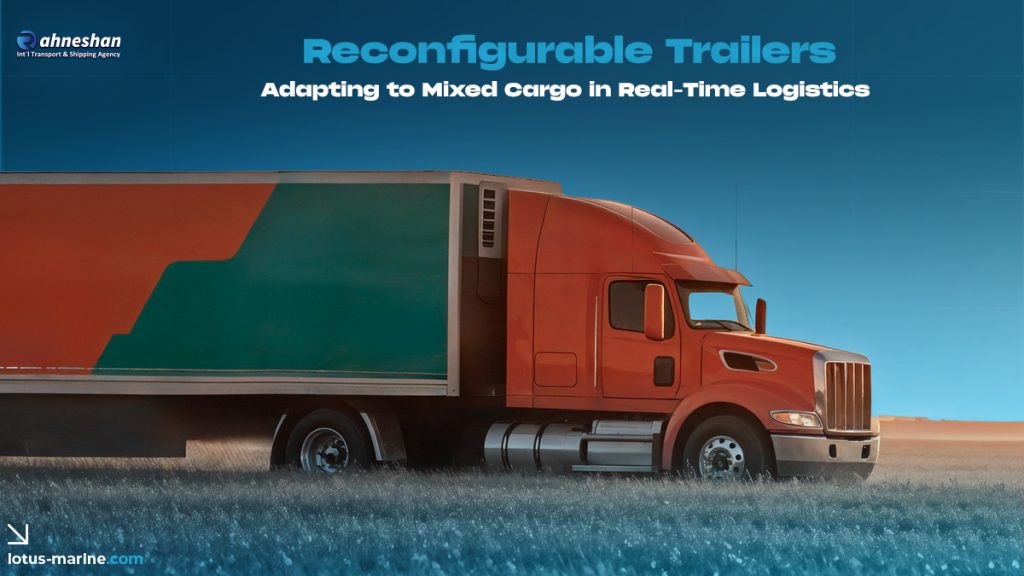Introduction
In today’s fast-moving logistics world, customers demand greater flexibility, faster turnaround, smaller lots and more mixed-cargo shipments. That means you may need to move pallets, loose boxes, bulk material and even special-handling goods in the same run — or dynamically switch from one cargo type to another en-route. A key innovation meeting that need is the reconfigurable trailer: a trailer whose internal layout, loading equipment, compartment divisions or even body-type can be altered rapidly to adapt to mixed-cargo flows. For logistics companies and freight-forwarders targeting B2B clients, deploying reconfigurable trailers offers a competitive edge in cost-efficiency, responsiveness and service quality.
What Are Reconfigurable Trailers?
Reconfigurable trailers refer to road-haulage trailers that provide adjustable internal configurations—such as movable bulkheads, adjustable floor systems, modular compartments, sliding rails, or convertible body styles—enabling quick adaptation between different cargo types (e.g., palletised goods, bulk loose-load, roll-on/roll-off, mixed shipments) within the same vehicle.
For example, some trailer fleets already promote units that handle “palletised, bulk, or mixed cargo” thanks to moving-floor or walking-floor technology. Qualified Logistics & Transport These trailers provide one part of the flexibility needed for mixed-cargo tasks.
On a system level, reconfigurability is also studied in the logistics research community (for vehicles/fleet) as a way to optimise fleet size and mix under variable demands. ResearchGate
Key Benefits for Logistics & Freight Forwarders
Here are several major advantages of deploying reconfigurable trailers:
1. Better asset-utilisation & fewer empty miles
Since a trailer can shift configuration to carry different cargo types rather than being idle or waiting for perfect load, utilisation improves. Fewer repositioning or under-loaded trips means cost per tonne-kilometre goes down.
2. Faster turnarounds & more flexible scheduling
When you can change the trailer layout quickly (e.g., switch from full pallets to mixed pallets + loose boxes) you reduce dwell time at depots, speed up loading/unloading and respond better to ad-hoc customer demands.
3. Serve mixed-cargo B2B clients more effectively
Many B2B clients today require one-stop solutions: they want you to carry diverse cargo types (e.g., machine parts + consumables + returns) in a single run. Reconfigurable trailers enable you to offer that kind of flexibility.
4. Cost savings via consolidation
Because you can mix cargo types more easily, you can consolidate more loads onto fewer vehicles — reducing fleet and driver cost, and reducing per-shipment cost for your B2B clients.
5. Competitive differentiation & value-added service
By promoting your logistics service as “adaptable in real-time to your mixed-cargo needs”, you position yourself as a strategic partner rather than a basic carrier—helping you win higher-value B2B contracts.
Considerations & Challenges in 2025
While the benefits are compelling, implementing reconfigurable trailers comes with challenges:
1. Investment & maintenance costs
The more complex the trailer configuration system (movable bulkheads, hydraulic floors, sensors, modular attachments), the higher the cost and maintenance risk. You must calculate ROI carefully.
2. Operational complexity & training
Drivers, yard-staff and loaders must be trained to operate the reconfigurable systems. Mistakes in configuration could delay loading/unloading or risk cargo damage.
3. Planning & software integration
To fully leverage reconfigurability you need logistics-systems that can plan loading sequences, cargo mix, compartment use and routing dynamically. This requires integration of advanced planning tools with your trailer-fleet operations.
4. Matching cargo mix and constraints
Even with reconfigurable trailers, mixing cargo types implies different handling requirements (e.g., fragile items, hazardous goods, bulk). You must ensure the configuration supports the specific handling, weight-distribution and loading/unloading constraints.
5. Market & demand variability
If your load-base is not sufficiently mixed (i.e., you predominantly carry one type of cargo), the investment may not pay off. Forecasting and demand-analysis are key.
Strategic Recommendations for Freight Forwarders & Carriers
To capitalise on this trend and generate B2B leads, consider the following:
-
Audit your cargo-mix and client demands: Identify customers who routinely ship mixed cargo or need flexible shipment solutions. Highlight your reconfigurable-trailer capability in your proposals.
-
Invest selectively: Start with a few reconfigurable units or modular trailers and offer them to high-value B2B clients requiring flexibility; collect case-studies to prove value.
-
Integrate trailer-configuration in your quoting process: Show clients options: “Standard trailer” vs “Reconfigurable trailer – for mixed-load profile”, and highlight lead-time savings, potential consolidation savings, and flexibility.
-
Train operations & yard staff: Ensure your team handles configuration changes efficiently, minimises dwell time, and avoids damage.
-
Use data & marketing: Collect metrics (e.g., number of configurations changed, dwell-time reduction, extra loads carried) and use them in your B2B content marketing—blog posts, LinkedIn articles, your website. Showcase how you reduce cost, improve flexibility and handle diverse customer needs.
-
Offer premium service tiers: For example, clients pay a premium for “Mixed-Cargo Adaptive Trailer Service” that ensures your trailer configures to their changing needs mid-route and supports varied goods.
Outlook for 2025 and Beyond
-
According to the market outlook for trucks and trailers, 2025 looks like a stabilisation period in some regions, but demand for flexible and sustainable solutions remains strong. ING Think
-
The broader logistics trend favours modularity, flexibility and mixed-load trade flows (including B2B and B2C). yamato-hd.co.jp+1
-
Reconfigurable trailers align well with these trends: as supply-chains require greater agility, carriers who invest in adaptable assets will have an advantage.
-
Over time, trailer manufacturers may build “plug-and-play” modules (bulk-floor, pallet-racks, roller beds) that can be swapped quickly, further reducing change-over time and increasing utilisation.
Frequently Asked Questions
Q1. What types of cargo benefit most from reconfigurable trailers?
A1. Mixed-loads where you might carry pallets + loose boxes + bulk items in one run; clients who have varying shipment types from week to week; industries requiring high flexibility (e.g., automotive parts, machinery + consumables, e-commerce + returns).
Q2. How fast can a trailer be reconfigured?
A2. It depends on the design—some systems with movable bulkheads or adjustable rails can change layout in under an hour or less; others (modular body swaps) take longer. Planning for configuration time is critical.
Q3. Does it require special software?
A3. Yes — to fully exploit the flexibility you should integrate trailer-configuration data into your transport-management system (TMS) or fleet-planning software so you can match cargo-mix, loading/unloading sequence and routing dynamically.
Q4. Is this only valuable for long-haul trucking?
A4. Not necessarily. While long-haul benefits a lot from higher utilisation, even regional or last-mile fleets can benefit if they serve diverse cargo mixes and need to adapt quickly.
Q5. How do we market this capability to B2B clients?
A5. Highlight the benefit of “we handle your changing cargo profiles without extra cost or delay”, show proof-points (e.g., “we switched trailer config mid-run to accommodate additional bulk item and saved you 1 extra truck”), and position your company as a flexible logistics partner rather than a static carrier.
Conclusion
In a logistics environment where flexibility, speed and mixed-cargo capability are increasingly critical, reconfigurable trailers offer a compelling value proposition for freight forwarders and carriers targeting B2B clients. By investing in adaptable trailer assets, integrating operational systems, training your workforce and showcasing your value to clients, you can convert what looks like an operational improvement into a strategic differentiator.
If your company positions itself as a partner that can adapt its transport‐assets in real-time to your customer’s evolving needs, you are more likely to win high-value clients whose cargo profiles are diverse and whose expectations are rising.
If you like, I can tailor this article specifically for the Middle East/Caspian corridor and include local market factors, competitor examples and a call-to-action perfect for your site (e.g., “Request a Mixed-Cargo Trailer Consultation”). Would you like me to go ahead with that?






